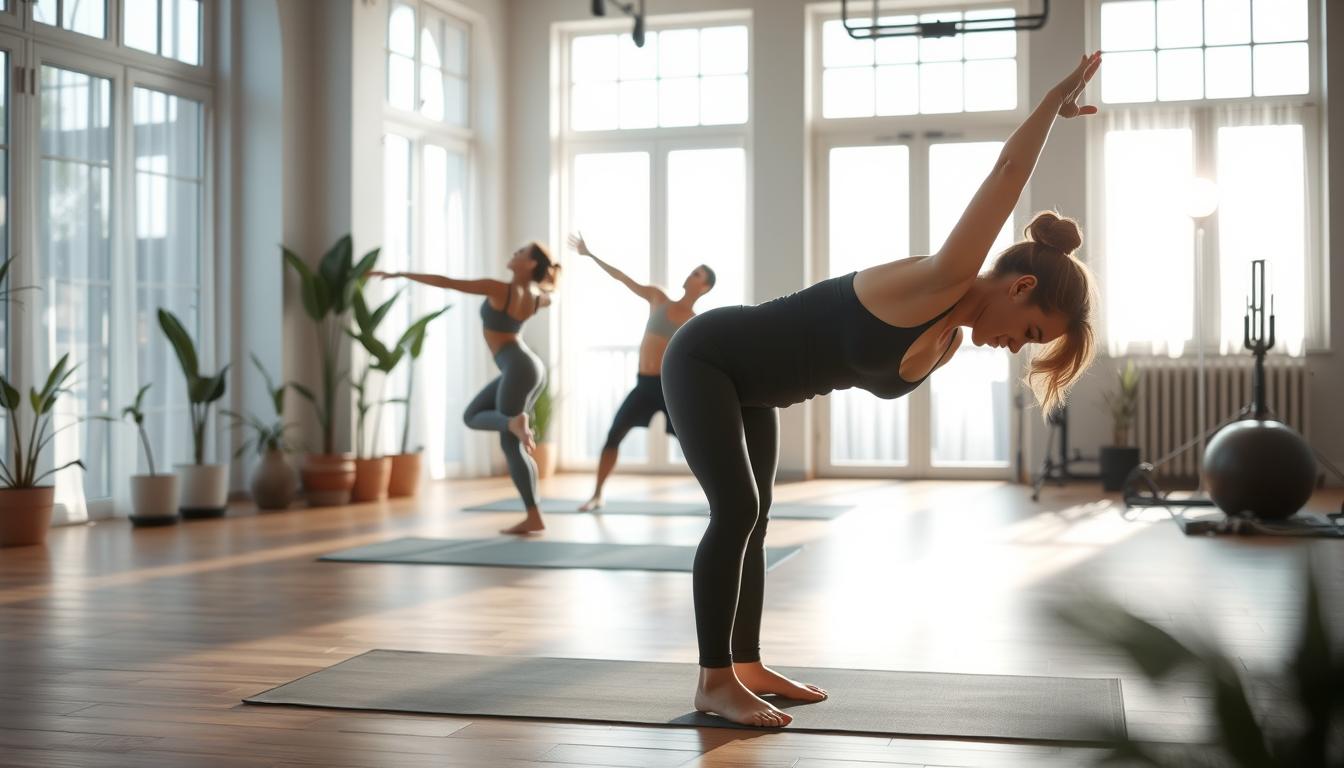Finding time to work out is tough in our busy world. But, doing quick exercises during elevator stops can really help you stay fit while you’re moving. Elevator workouts are a smart choice for those who don’t think they have time to exercise. These short workouts are easy to fit into your day and keep you in shape without long gym visits.
Short exercises, like 10-15 minutes long, can make you feel better mentally and improve your health. Studies show that mixing fast and slow exercises can help you lose fat and get faster and stronger. Also, using stairs instead of elevators, or changing up your exercise speed, can help you meet your fitness goals. Even when life is busy, simple activities can be part of your exercise routine and help keep you healthy.
The Importance of Staying Active on the Go
Staying active is key to our health and happiness. Moving our bodies fights off serious illnesses like heart disease and diabetes. Just a few short bursts of high-energy activity each day can greatly lower the risk of heart and cancer-related deaths. These quick workouts improve our physical state and help our minds by lowering feelings of anxiety and depression.
In today’s world, where sitting too much is common, it’s important to find creative ways to move more. Simple activities, like running up stairs or doing jumping jacks, can make a big difference. They not only boost your physical health but also make you feel happier and more energized all day.
Adding muscle-strengthening moves, like squats or push-ups, to moments of waiting is a smart way to stay active. Planning short exercise breaks can help you gain health benefits little by little. Actions like a quick walk or a light jog not only keep your body fit but also sharpen your mind, making them perfect for busy people.
Understanding Micro-Exercising as a Fitness Solution
Micro-exercising is also known as exercise snacking. It’s great for busy people’s schedules. It focuses on short exercises that are 10 minutes or less. These short activities, done throughout the day, have big health benefits. Studies show they’re as good as longer workouts for your heart and metabolism.
A micro workout includes three key types: a push, a pull, and a squat. You should do each at a moderate effort, about 60-70% of your hardest try. You won’t tire out your muscles this way. Some good exercises are push-ups, pull-ups, and squats. You can change them up to keep it interesting.
Setting goals for how many reps you do can improve your micro workouts. For instance, try for 50 push-ups, 20 pull-ups, and squats. Then, hold a pose for 30 seconds and do 20 more squats. Reaching these goals means you can try harder exercises next. This makes you keep getting better.
Research suggests splitting your exercise into 10-minute bits can lead you to work out more often and longer. You can do these mini workouts anywhere, like during a break or waiting for an elevator. This makes staying fit easier for folks with a lot to do.
For a well-rounded fitness plan, adding high-intensity workouts to your routine is smart. This helps your heart health. Following the American Heart Association’s advice of getting 150 minutes of exercise a week works with micro-exercising. It shows this method helps you get stronger, more enduring, and keeps you motivated.
Quick Workouts Between Elevator Stops
Fitting workouts into your day is very good for your health, especially when you’re busy. Doing short exercises between elevator stops is a great way to include exercise into your day. These quick workouts help your heart, make your muscles stronger, and increase your energy. They also fight the negative effects of sitting too much.
Benefits of Short Exercise Bursts
Short bursts of exercise have many benefits:
- Improves cardiovascular health by increasing heart rate.
- Enhances muscle tone through exercises like standing calf raises and squats.
- Boosts energy levels, helping combat fatigue.
- Encourages effective weight management, countering sedentary habits.
- Improves flexibility with stretching exercises such as hamstring stretches and shoulder rolls.
How to Incorporate Quick Workouts into Your Day
To take advantage of the time between elevator stops, try these workout ideas:
- Perform standing calf raises to tone your calves while waiting.
- Try buttock pinches to engage your glutes.
- Incorporate abdominal flexes for core strength.
- Execute lateral raises using water bottles or books for upper body conditioning.
- Challenge yourself with vertical jumps to strengthen legs and core.
- Practice the Tree Pose for balance improvement.
- Fit in a squat challenge to enhance both leg and core strength.
By actively adding simple exercises to your daily routine, you can enjoy the benefits of short workouts. This turns time spent waiting into a chance to improve your health.
Simple Bodyweight Exercises You Can Do Anywhere
Bodyweight exercises are a great way to stay in shape, no matter where you are. You don’t need any equipment, which makes them perfect for quick workouts. They can help you build strength and make your heart healthier.
Effective Exercises for Stronger Muscles
There are many bodyweight exercises that work well for your muscles. For example:
- Lunges: They build strength and stability. Try 3 sets of 8-10 reps for each leg or 45 seconds on, 15 seconds off, for 5 minutes.
- Push-ups: This basic exercise targets the chest, shoulders, and triceps. Go for 3 sets of 12-15 reps. It can be changed to match your ability.
- Burpees: A combo of cardio and strength, do 2-4 rounds of 40 seconds on, 20 seconds off.
- Situp Roll Burpee: Mixes burpees and situps for a tough core workout. Set a clock for 5-10 minutes, with 30 seconds on and off.
Cardiovascular Movements to Keep Your Heart Healthy
Adding cardio exercises to your plan is good for your heart and stamina. Here are a few choices:
- Jump Squats: Improve power and endurance. Work for 30 seconds, then rest for 30.
- High Knees: A fast-paced exercise that quickly raises your heart rate.
- Arm Circles: Perfect for a warmup. They work the shoulders and core.
- Bird Dogs: Awesome for stretching your body and keeping your heart rate up.
Utilizing Stairs for Quick Fitness
Stair climbing exercises are great for busy people to boost their fitness. They mix ease with tough workouts. This exercise improves heart health, builds strength, and burns a lot of calories. A study in the British Journal of Sports Medicine showed that short, intense stair climbs can greatly lower heart disease risk and improve health.
The Effectiveness of Stair Climbing
Stair climbing is a high-effort activity, making it a strong choice for fitness plans. It has an MET value around 6 for both women and men, which means it uses a lot of energy. Climbing six to ten flights daily can dramatically reduce heart disease death risk by 39%. Adding stair climbing to your workouts can offer big health boosts, especially if you’re usually not very active.
Creating a Stair Workout Routine
To build a good stair workout, follow these tips:
- Start with easy stair climbs for 1-3 minutes, then slowly do more.
- Add lunges or step-ups at each landing to build strength.
- Include stair climbs in a mix of exercises, like push-ups or squats, for an overall body workout.
Stair workouts fit easily into any schedule, making it simple to get fit even on busy days. Regular stair climbing not only boosts your fitness but also gives quick exercise breaks throughout your day.
Quick Workouts for Busy Professionals
It’s hard for busy professionals to find time to exercise. They can fit short workouts into office breaks to stay healthy. These workouts refresh the mind and body, boosting productivity.
Best Exercises During Office Breaks
- Stretch during phone calls: Stretch your muscles and work on your posture while on a call.
- Take greater strides: Use breaks for brisk walks. Bigger steps help your heart and health.
- Jumping jacks: This exercise boosts your heart rate and fits in small spaces for quick energy.
- Plank exercises: Strengthen your core and posture with planks, no equipment needed.
- HIIT Workouts: Short, high-intensity workouts, like jump squats and push-ups, take 15-20 minutes. They’re efficient and powerful.
Integrating Movement into Your Work Environment
Making fitness a part of work improves your health and creates a wellness culture. Here are some ways to do it:
- Choose stairs over elevators to work your legs, heart, and burn calories.
- Suggest walking meetings to keep moving during the day.
- Start the day with stretches and strength exercises, even in bed to get energized.
- Stretch at your desk to reduce stiffness from sitting too long.

Tips for Making the Most of Small Spaces
Small spaces don’t stop you from being active. Many manage to exercise in tiny areas without big gyms or lots of gear. By adjusting routines to fit snug spaces, you can keep fit effectively.
Adjusting Exercises for Your Environment
With little space, certain exercises work really well. Yoga and Pilates are great, focusing on low-impact moves for flexibility. You can also do seated leg extensions and wall push-ups with just a wall or chair. This lets you keep up strength training anywhere.
Chair squats and tricep dips help build muscle with no gym stuff needed. It’s all about being clever with your space.
Using Available Resources for Effective Workouts
Turning any spot into a workout area is easy with the right items. Low-impact cardio like marching in place boosts heart health in tight spaces. Using exercise balls, dumbbells, and resistance bands lets you do diverse exercises. Also, don’t forget to stretch to stay flexible and avoid injuries.
Small space exercises can halve the risk of long-term diseases, says the American Journal of Preventive Medicine. Though outdoor activities like walking and running are top-notch, jump ropes are a cheap way to add cardio indoors.
Tracking Your Progress and Staying Motivated
It’s key to track your fitness journey to meet your goals. Jotting down details like the exercise date, kind of workout, weight, sets, and reps helps see your progress. Also, noting how hard workouts feel, rest days, and weight changes can show how well you’re doing and when to tweak your routine for better results.
Setting Realistic Fitness Goals
Goals should be realistic and precise to keep you driven. Plan to do small workouts each week or keep track of how long you use the stairs every day. A workout diary keeps you consistent and honest. Reviewing your progress every month or so highlights your wins, big or small, keeping you focused and happy.
Incorporating Friendly Competition
Adding a fun competition at work can make fitness more exciting. Team challenges build accountability and friendship, which makes chasing fitness goals fun. Sharing your progress and successes creates a support network that boosts everyone’s commitment. Digital apps make sharing victories and keeping a workout streak easier.
Conclusion
In today’s fast-paced world, fitting quick exercises into short breaks, like while waiting for elevators, can change our fitness habits. These quick workouts help us use small moments throughout the day to stay active without much effort. Each little effort adds up, improving our physical health and overall happiness.
When we come across elevator problems, like stuck buttons or doors, it’s a chance to add exercise to our day. These moments can become opportunities for a short workout. Seeing these times not as delays, but as chances for exercise, is key.
Putting fitness into our daily life lets us break free from usual workout routines. Using tools like AuditMate for tracking elevators shows we can make every moment count. Next time you’re waiting, think of it as a chance for a mini workout. This helps remind us how important moving is for a healthy life.



